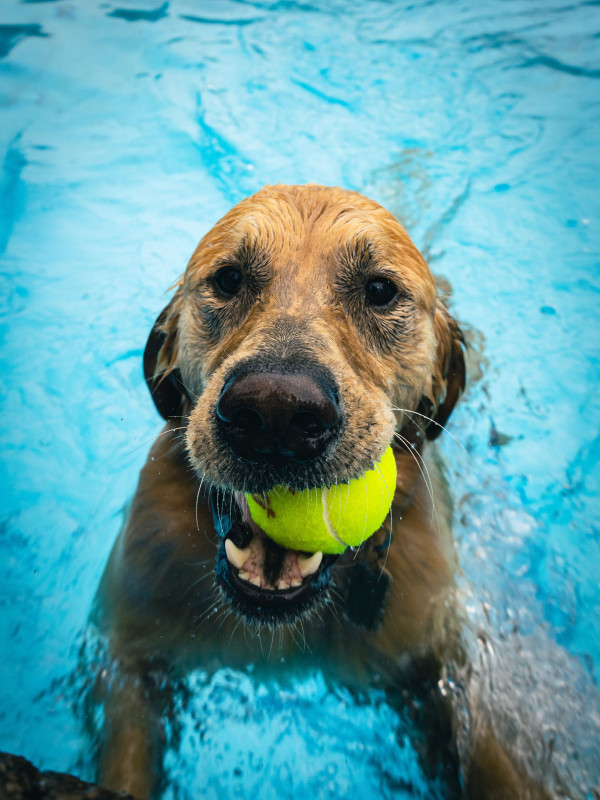
Splash Safely: Water Hazards Pet Parents Should Know This Summer
As temperatures rise and the sun lingers longer, many pet parents look forward to sharing summertime adventures with their dogs. Whether it's a lake day, paddleboard outing, or backyard sprinkler play, water-based activities offer physical exercise, mental stimulation, and welcome relief from the heat. However, they can also carry hidden hazards.
While most owners are aware of potential dangers such as drowning or overexertion, fewer realize that parasites, toxic algae, chemical exposure, and even overhydration can pose serious risks to dogs in aquatic environments.
Giardia: The Hidden Parasite in Puddles and Ponds
One of the most common threats lurking in natural water sources is Giardia duodenalis, a microscopic intestinal parasite. Dogs typically contract Giardia by drinking from contaminated water sources, such as puddles, ponds, or slow-moving streams. Once inside the gut, Giardia attaches to the intestinal lining and interferes with nutrient absorption, leading to symptoms like greasy or malodorous diarrhea, vomiting, flatulence, bloating, and weight loss. Some dogs, particularly healthy adults, may exhibit no symptoms while still shedding infectious cysts in their stool, thereby contributing to environmental spread.
The parasite is more prevalent in areas with high rainfall, livestock runoff, or poor sanitation. It’s especially common in the Pacific Northwest, the Southeastern U.S., and mountainous regions where surface water is abundant. Unfortunately, Giardia cysts are highly resistant to chlorine and cold temperatures, making them difficult to eliminate through conventional disinfection.
Pet owners can reduce risk by carrying clean water on hikes and walks, discouraging their dogs from drinking out of puddles or communal water bowls, and maintaining hygiene by regularly washing bowls, bedding, and even bathing their dogs after outdoor excursions. If an infection occurs, veterinarians typically prescribe antiparasitic medications such as metronidazole or fenbendazole, often in combination, and emphasize environmental sanitation to prevent reinfection.

Photo by wirestock
Cyanobacteria: A Lethal Summer Threat
One of the most dangerous waterborne hazards pets can face during summer is cyanobacteria, commonly known as blue-green algae. These photosynthetic microorganisms thrive in warm, nutrient-rich, stagnant bodies of water, especially between late spring and early fall. When environmental conditions align, cyanobacteria can reproduce explosively, forming dense surface blooms that often appear green, brown, red, or blue, and may emit a foul odor or create a scummy residue on the water’s surface.
While not all cyanobacteria produce toxins, certain species generate highly potent compounds, such as microcystins, which damage the liver, and anatoxins, which impact the nervous system. Dogs can become exposed by drinking contaminated water or by licking algae off their fur after swimming. Signs of exposure can appear rapidly and include drooling, vomiting, weakness, tremors, seizures, difficulty breathing, liver failure, and even death, sometimes within hours.
In recent years, confirmed cyanobacteria-related illnesses have been reported in 15 states, including pet deaths in Washington and California. These events have prompted increased public health awareness and monitoring efforts. Climate change, increased temperatures, agricultural runoff, and nutrient pollution have all contributed to more frequent and severe harmful algal blooms (HAB) across the U.S. Real-time monitoring tools are now available through agencies such as the U.S. Environmental Protection Agency (EPA) and the National Oceanic and Atmospheric Administration (NOAA) to help track bloom conditions and inform the public of risks in their area.
To protect pets, owners should avoid any body of water that appears discolored, foamy, scummy, or has a musty or sewage-like odor. Even if signs are not visible, it’s best to check local advisories or Harmful Algal Bloom (HAB) maps before visiting lakes or ponds. After any outdoor swimming, rinse dogs thoroughly, especially if the water quality is uncertain. Importantly, contact a veterinarian immediately if a dog shows sudden symptoms after exposure to water, as the timing is critical in suspected cyanotoxin poisoning.
Chemical and Heavy Metal Hazards: The Invisible Threats
Even when a water source appears clear and refreshing, it may conceal unseen threats, especially near agricultural fields, industrial zones, or urban runoff channels. Harmful substances, such as pesticides, fertilizers, volatile organic compounds, and heavy metals like lead, mercury, and arsenic, can accumulate in stagnant water through stormwater runoff, leaching from infrastructure, or contaminated soil. These contaminants often originate from nearby roads, lawns, or construction areas and are rarely monitored in recreational or natural water sites used by pets.
Chronic or acute exposure to heavy metals and industrial chemicals can result in significant health issues in dogs. Lead poisoning, for instance, may present as gastrointestinal distress, anemia, or neurological abnormalities such as seizures or behavioral changes. Mercury can cause renal failure and tremors, while arsenic exposure may result in vomiting, diarrhea, and cardiovascular collapse. Long-term exposure risks are particularly concerning near older urban parks with aging infrastructure or agricultural runoff zones.
Urban runoff after storms also plays a major role in chemical contamination. Rainwater can carry hydrocarbons, lawn treatments, and industrial residue into rivers, ponds, and even public dog parks. While these contaminants may be present in trace amounts, cumulative exposure, especially through repeated drinking or swimming, can pose toxicological risks.
Swimming pools and spas, while appearing more controlled, present their own challenges. Ingesting chlorinated water can lead to gastrointestinal upset or electrolyte imbalances, particularly if the chlorine concentration is elevated due to recent treatment. Sodium hypochlorite, a common pool sanitizer, can irritate the mouth, throat, and gastrointestinal tract if ingested. Saltwater pools and ocean beaches carry the added danger of salt poisoning, known as hypernatremia, if a dog drinks excessive saltwater, which may cause vomiting, lethargy, seizures, or even death.
To protect pets, dog owners should bring clean, fresh water on outings and discourage their pets from drinking from unfamiliar or untreated sources. Rinsing a dog’s coat and paws after swimming helps remove any lingering toxins that could be ingested during grooming. Caution is also advised when visiting parks or beaches following heavy rainfall, as runoff is most concentrated during this period.
Water Intoxication: When Too Much Water Becomes Dangerous
While dehydration is a well-known risk for dogs during summer, fewer pet owners realize that overhydration, or water intoxication, can be equally life-threatening. Known medically as hyponatremia, this condition occurs when a dog ingests an excessive volume of water in a short time, diluting sodium levels in the bloodstream. This electrolyte imbalance disrupts normal cellular function, leading to dangerous swelling in the brain and other tissues.
Water intoxication is most often seen during vigorous or prolonged water play. Dogs that obsessively chase toys in lakes, bite at sprinkler streams, or swallow large amounts of water while swimming are particularly vulnerable. Small dogs and puppies are at higher risk due to their lower body mass, which requires less water intake to trigger imbalance.
Clinical signs typically appear suddenly and may include vomiting, pale gums, loss of coordination, dilated pupils, lethargy, bloating, and seizures. If untreated, water intoxication can rapidly progress to coma or death. Early recognition and emergency veterinary care are critical.
To prevent water intoxication:
- Limit water play to short, supervised intervals.
- Encourage breaks and offer clean, fresh drinking water throughout the activity.
- Avoid toys that promote excessive water gulping or prolonged submersion.
- Monitor dogs closely for changes in behavior, especially after swimming or sprinkler play.
If your dog appears dazed, stumbles, or exhibits unusual behavior following aquatic activities, don’t delay; seek veterinary help immediately. Time is critical in managing hyponatremia effectively.

Photo by Olga_Ovcharenko
General Water Safety: Supervision, Fatigue, and Awareness
Beyond illness and toxicity, water itself can pose a physical danger. Contrary to popular belief, not all dogs are natural swimmers. Breeds with flat faces or heavy bodies, such as Bulldogs, French Bulldogs, and Pugs, struggle to stay afloat due to their limited respiratory capacity and body structure. Even confident swimmers can get caught in strong currents, encounter submerged obstacles, or become fatigued before they can reach shore.
Drowning in dogs is often silent. They don’t thrash or bark for help like people might. Instead, they may quietly panic, paddle aimlessly, and submerge before anyone notices. Pet owners should always supervise dogs during water activities, especially in deep or unfamiliar water. Canine life jackets are strongly recommended for boating, paddleboarding, or visits to lakes or rivers with unpredictable depths or currents.
Even after safe swims, dogs should be dried thoroughly and checked for signs of ear infections or paw irritation, particularly between the toes. Sessions should be kept short, ideally no more than 10 to 15 minutes at a time, to avoid overexertion, especially for elderly, young, or overweight pets.
Final Thoughts: Smart Habits for a Safe Summer Splash
Summer offers endless ways to enjoy the outdoors with your dog, but warm-weather water fun carries more complexity than meets the eye. From Giardia and cyanobacteria to hidden chemical threats and water intoxication, the risks are real, but preventable. As environmental factors continue to shift, pet owners must stay proactive and informed.
By practicing good hygiene, avoiding risky water sources, thoroughly rinsing dogs after swimming, monitoring their behavior during play, and watching for early signs of distress, you can ensure that your dog has a summer full of joy, not danger. Preparedness and vigilance can make all the difference between a carefree splash and a trip to the emergency vet.
Follow us on LinkedIn for the latest updates on all things happening here at BSM Partners.
About the Author
Lee Ann Hagerty is Director of Customer Enrichment and Consumer Insights on the BSM Product Innovation team with 29+ years in the pet food industry, working for Iams/Eukanuba, Procter & Gamble, and Mars Pet Care. She brings a unique combination of project management skills with consumer insights, product design, animal nutrition, and sensory science which drives an in-depth understanding of the pet and consumer. Lee Ann has a passion for helping dogs. Over the last year and a half, she has fostered over 22 dogs. Many of them were senior dogs who had lived their entire lives outside as hunting dogs. She has been a foster pet parent for many years, and it brings her great joy to see these pets find fur-ever homes where they live with families indoors with love and care.
This content is the property of BSM Partners. Reproduction or retransmission or repurposing of any portion of this content is expressly prohibited without the approval of BSM Partners and is governed by the terms and conditions explained here.